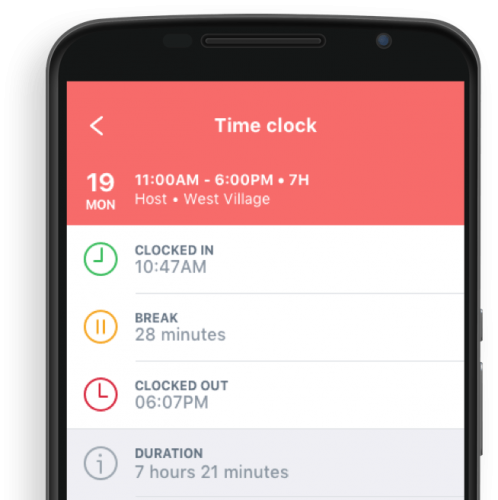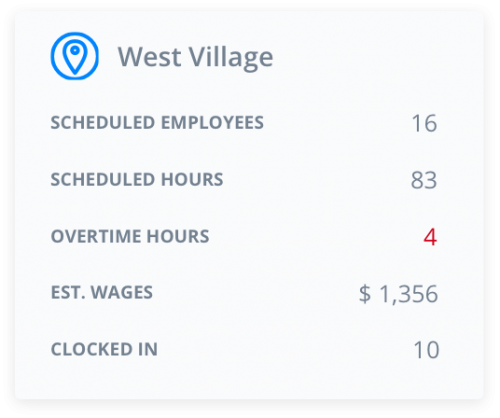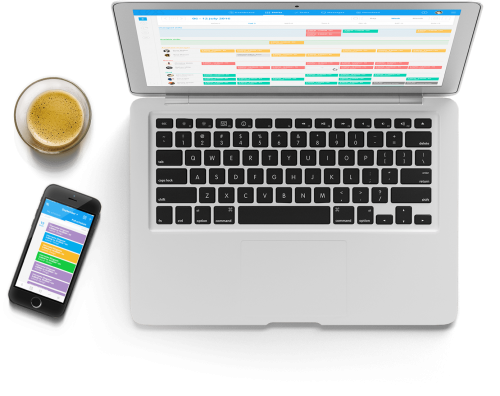The best way to calculate work hours: A must-have guide
Struggling to keep up with payroll? Let the experts at Sling show you a better w...

Clocking in and out used to require employees to fill out a paper worksheet or punch in using a manual time clock. Those methods were fine for their day, but now there’s a better way to track work hours: cloud-based web platforms like Sling.
But the integration of this advanced technology raises a number of questions, including:

One of the many nice things about cloud-based software solutions like Sling is that they only require a very basic computer and an internet connection. That means you won’t have to hire an IT person to retrofit your business. Your employees won’t have to take classes to figure out how to make the app work. And you won’t have to dip into your savings to buy an expensive computer to handle the software. Everything is done online.
To get started, you’ll need to set up a time clock that integrates with cloud-based software so your employees can clock in and out. You’ll also need a computer with an internet connection in your office so you can calculate time cards. You can simplify the process even further by allowing your employees to clock in and out using their own smartphones. This is possible because a web-based platform like Sling links every device that you specify to your account in the cloud. We’ll investigate how this works in the next section.

Using a web-based software solution on a mobile device for clocking in and out couldn’t be simpler. We’ll walk you through it using Sling as an example.
All the information is added to the employee’s time card report which can be accessed via the computer in your manager’s office.
The app even allows this data to be exported, if necessary, for payroll calculation. It’s just that simple. And this is only one of many benefits when you allow your employees to clock in and out using an app like Sling.

Before you concentrate on improving the way your employees clock in and out, you need to define what full-time and part-time mean for your business.
Standard practice for most businesses is 40 hours per week, but that stems from the 1940 amendment to the Fair Labor Standards Act (FLSA) that set limits on how many hours employees could work without receiving extra compensation.
That simply meant that businesses could only require their full-time employees to work 40 hours per week. If they worked more, they were entitled to receive overtime pay.
The law only set the upper limit for regular compensation (40 hours). It didn’t prevent businesses from defining full-time differently (as long as it didn’t exceed 40 hours per week).
That gives managers and business owners the freedom to set their own number as full-time.
For example, some businesses and government agencies define full-time as 35, 32, or even 30 hours per week. It all depends on the unique needs of your business.
Once you’ve defined full-time for your business, you also need to establish what part-time hours are.
Technically, part-time hours would be any number less than your definition of full-time. You could schedule your part-time team members for 20 hours per week, 30 hours per week, or even 39 hours per week if you so chose.
But before you set your part-time hours at one less than full-time, keep in mind that your part-time employees will likely feel that they’re working too much for too little compensation (including benefits granted to full-time employees).
As it was with establishing your own full-time number, you have the freedom to set whatever part-time number you feel works for your business. For simplicity’s sake, most businesses define part-time as half of their full-time number.
For example, if you define a full-time team member as working 40 hours per week, a part-time team member would be one who works 20 hours per week.

Clocking in and out records the number of hours an employee works each week. Attached to those numbers are several key variables that affect both the team member and your business.
First and foremost are the number of hours they work consistently throughout the week.
Giving one employee a full-time designation usually indicates that the team member will be working at least that many hours week after week.
So if full-time for your business is 35 hours, your full-time employees will be working that number consistently throughout the year.
On the other hand, the part-time designation doesn’t mean you have to schedule those team members for that number of hours every week.
If you define part-time as 20 hours per week, some weeks your part-time employees may work those 20 hours, while other weeks they may work less.
Two more key variables related to full-time, part-time, and clocking in and out are pay and benefits.
When it comes to tracking hours and figuring payroll, it’s not necessarily about how much each employee is paid (a part-time employee can make just as much as a full-time employee). Rather, it’s about how that pay is calculated.
Part-time employees are most often paid by the hour. So if their pay rate is $15/hour and they work 20 hours in one week, you’ll pay them $300.
You can also pay full-time employees by the hour, but most businesses pay them a flat salary regardless of the hours worked in a week. So a full-time (40 hours per week), salaried employee making $20/hour receives a paycheck for $800 whether they work 40 hours or 45 hours.
Closely related to that is the concept of benefits. Benefits are extra forms of compensation that your business provides in addition to the hourly wage or salary.
Common benefits include:
Really, anything other than the wage you pay your team members is a benefit. Those benefits become crucial when you take the time to analyze your employees’ output versus what they receive for that work.
When you add up all the hours they accumulate from clocking in and out and value the work they accomplish, does it equal what you give them in terms of pay and benefits?
The variables mentioned above — number of hours, pay, and benefits — directly affect the bottom line of your business. Consider incorporating apps into your work process that make the calculating these variables — as well as clocking in and out — simpler to understand and perform.
If simplified clocking in and out isn’t enough, here are 5 other benefits that are only possible with apps like Sling.

With web-based apps like Sling, you can set up notifications the remind your employees to clock in and out when they’re supposed to. This helps avoid problems when it’s time to calculate your employees’ time cards.

You can log in to the Sling app at any time (and from anywhere) to see exactly who is clocked in or out. This helps monitor what’s going on in your business when you can’t be there, or when you have to stay in your office to finish another task.
Sling helps prevent unauthorized overtime by providing the app administrator (or administrators) with tools to limit early or late clocking in and out.
The secure nature of cloud-based apps like Sling mean that employees can no longer clock in and out for each other. This prevents chronically-late employees, or employees who leave early, from falsifying their records with the help of a friend.
When you use an app like Sling you can quickly see who has arrived late or left early. Monitoring and recording tardiness in this way can help correct employee behavior down the line.
These are just a few of the benefits that you can hope to gain by incorporating a time-tracking app like Sling. But the mobility allowed by web-based apps like Sling means that new rules and regulations should be established to govern employee behavior. Here’s an example of these rules and regulations.

The following items should be clearly listed in your employee handbook. Keep in mind that we cannot list every rule and regulation you may need for your business. Tailor the items on this list (and the language used) to fit your requirements.
For all employees and departments:
We’ve already covered the many time-tracking benefits you can gain by incorporating an app like Sling into your business infrastructure. But the benefits go far beyond just keeping track of work hours. The real power of Sling lies in scheduling your employees so that clocking in and out goes as smoothly as possible.

Sling can have a profound impact on the time you spend scheduling employees, because it combines cloud-based distribution with powerful tools that make even the most complicated rotating shift schedules a piece of cake. Here are just a few of the benefits you can enjoy when you use Sling to schedule your employees:

While there are many apps that deal with scheduling or clocking in and out by themselves, only Sling combines the two into a powerful all-in-one solution for your business. Whether you’re establishing your own business-based newsfeed for employees, or creating tasks to help everyone work better, Sling is the best choice for busy managers who want to simplify both the scheduling process and clocking in and out.
For more free resources to help you manage your business better, organize and schedule your team, and track and calculate labor costs, visit GetSling.com today.
See Here For Last Updated Dates: Link
This content is for informational purposes and is not intended as legal, tax, HR, or any other professional advice. Please contact an attorney or other professional for specific advice.
Schedule faster, communicate better, get things done.